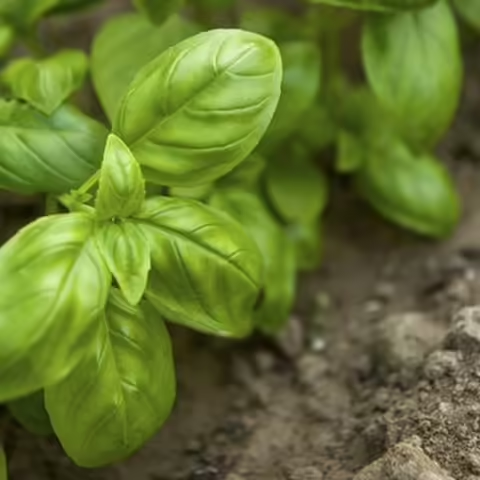Basil
Ocimum basilicum
Basil is one of the most popular and widely used culinary herb. It is a tender annual, aromatic plant with a spicy odor and flavor. It grows 12 to 18 inches tall and foliage color can range from green to purple. Foliage size can vary from large lettuce-like leaves to very small leaves, half inch in size.
Growing: Annual
Basil is easily grown from seed or from tip cuttings of overwintered plants. Because basil is sensitive to cold temperatures, seeds germinate and grow best when the media temperature is at least 70 degrees. Seeds will germinate in about 5 to 7 days. If sowing seed indoors to grow transplants for later use out in the garden, allow about 3 to 4 weeks to produce transplants suitable for transplanting well after the frost free date and when soil temperatures are at least 60 degrees and above. Cold soil and air temperatures can stunt basil growth and can even cause damage and blackened leaves at 50 degrees. Basil prefers a sunny location, and a soil that is well supplied with organic matter and is fertile. Basil also likes to be kept well-watered. Poorly prepared soils that are low in nutrients result in slow growing basil that is not very flavorful. Basil is excellent as a decorative/culinary herb in patio or balcony containers or in the garden.
Popular Varieties
Sweet Basil Group: These are the familiar sweet scented types.
- Napoletano – Standard lettuce-leaved.
- Medinette – Compact, large leaf.
- Romanesco – Large leaf with strong aroma.
Genovese Group: Classic large leaf from the Genoa area of Italy, the pesto capital of the world.
- Genovese – Classic.
- Emily - Compact variety.
- Dolly – Heavy produce of large leaves. More cold tolerant.
Bush Group: Smaller, rounded forms often with small, finer textured foliage.
- Spicy Globe – Uniform and dense.
- Green Globe – Dense, tight globe form.
- Bush – Standard bush variety.
Purple Group: Basils with dark purple to bronze foliage. They are often very decorative.
- Dark Opal – Pure dark purple foliage excellent for vinegars.
- Emerald Wine™ - Compact, wine red leaf veins surrounded by a green border.
- Rubin – Purple bronze foliage.
Other Basils: A selection of basils with distinctive flavors and aromas.
- Cinnamon – Distinctive cinnamon taste and aroma.
- Lemon – Intense lemon fragrance.
- Clove – Clove scented leaves.
- Thai – Licorice-like aroma.
Harvesting
Limited harvesting of the leaves can start on young plants and as they get larger, individual leaves as well as tips of the plants can be harvested. Pinching the tips of stems encourages a bushy plant and more leaf growth resulting in a round plant full of aromatic basil. Basil flower buds should be removed by pinching as soon as you see them form. Leaving them on the plant will affect the flavor of the leaves.
Use
Basil picked for use in the kitchen is best held in a glass of water at room temperature. Putting basil in the refrigerator results in discolored and unattractive leaves. Basil is easily dried for storing and future use. It is used to flavor soups, stews, tomato dishes, meat, game, fish, egg dishes, herb butters and herb vinegars.
Indoor Culture
Basil is easily grown as a window sill herb for fall, winter and early spring harvest. Sow several seeds in a small pot filled with a prepared potting media. Keep moist and place in a full sun location. Harvesting can begin in about 4 to 5 weeks. Making successive sowings of seed at 2 week intervals insures a continuous supply of fresh basil.
Illinois Extension photo: Herb Gardening | Sweet Basil
